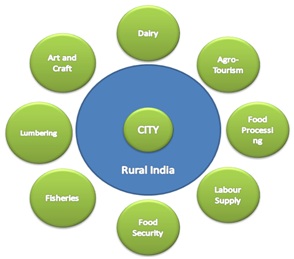

- In India, the rural areas have seen substantial development because government policies aimed at improving rural housing, sanitation and welfare have contributed to transforming its landscape.
- With half of India's population expected to be in rural India by 2050 and the bulk of the workforce emanating from rural India accounting for 70 percent of the total workforce , it Is widely acknowledged that the country's overall development will move parallel to the development of rural India.
- Since independence, rural India has remained at the periphery of development that urban India has achieved.
- Benefits trickled down to the rural hinterlands, but they were a far cry from the prosperity urban India enjoyed.

Important Government initiatives
Government made targeted efforts to improve rural livelihood with its initiatives. Some of which are as follows:
|
Name of the Scheme |
Silent Features |
|
Nai Roshni |
It has been instituted to empower women who are key change agents, contributing to inclusive and sustainable growth in rural communities. |
|
Ujjwala Yojana |
It aims at providing clean-cooking fuel to the poor households and bringing in qualitative charges in the living standards. |
|
Saubhagya Yojana |
It promises free electricity connections to all households (both APL and poor families) in rural areas and poor families in urban areas will be provided. |
|
Pradhan Mantri Awas Yojana — Gramin (PMAY-G) |
Under this scheme, financial assistance is provided for construction of houses. These houses are equipped with facilities such as toilet, LPG connection, electricity connection, and drinking water by making convergence with other schemes. |
|
Swachh Bharat Mission 2.0 |
This version speaks of sustained behavioural change while embarking on the newer agendas of sustainable solid waste management and safe disposal of wastewater and reuse. |
Bridging the Urban-rural Digital Divide:
- Government's Digital India campaign that aims to connect the entire country digitally has provided a great impetus to transform rural India to match its urban counterpart.
- In the meantime, digital technology has facilitated important 'quality of life' improvements in rural areas. Besides enabling tech-ecosystems, digital infrastructure has helped attract higher-paying jobs and allows remote work too; thus, addressing migration from villages.
- Rural youth have increased gains from economic activities through easy access to market information and global markets.
- These parallel processes help provide a competitive landscape for pricing and fair competition.
- Perhaps the most significant impact of internet penetration is the support it provides to rural entrepreneurship.
Initiatives for Educating Rural India:
Along with the National Education Policy 2019 that includes online learning as an alternative, the government has taken various initiatives to promote digital learning:
|
Name of the Initiative |
Silent Features |
|
National Mission on Education through Information and Communication Technology (NMEICT) |
It has been envisaged as a Centrally Sponsored Scheme to leverage the potential of ICT, in teaching and learning process for the benefit of all the learners in Higher Education Institutions in any time anywhere mode. |
|
SWAYAM |
SWAYAM seeks to bridge the digital divide for students who have hitherto remained untouched by the digital revolution and have not been able to join the mainstream of the knowledge economy. |
|
SWAYAM Prabha |
The SWAYAM PRABHA is a group of 34 DTH channels devoted to telecasting high-quality educational programmes on 24X7 bases using the GSAT-15 satellite. |
|
National Digital Library (NDL) |
It is a virtual repository of learning resources which is not just a repository with search/browse facilities but provides a host of services for the learner community. |
|
Free and Open-Source Software for Education (FOSSEE) |
This project promotes the use of FLOSS tools to improve the quality of education in our country. We aim to reduce dependency on proprietary software in educational institutions. |
|
National Skill Development Corporation (NSDC) |
NSDC aims to promote skill development by catalyzing creation of large, quality and for-profit vocational institutions. Further, the organisation provides funding to build scalable and profitable vocational training initiatives. |
Looking to the Future:
The pandemic has created a situation where even the urban dwellers chose to temporarily migrate to the safer, untouched rural lands for months or more. Rural natives have also chosen to stay at their hometowns and engage in traditional economic activities. The government and other social development organisations must grab this opportunity and initiate policies explicitly targeted at reverse migration.
Related Articles


